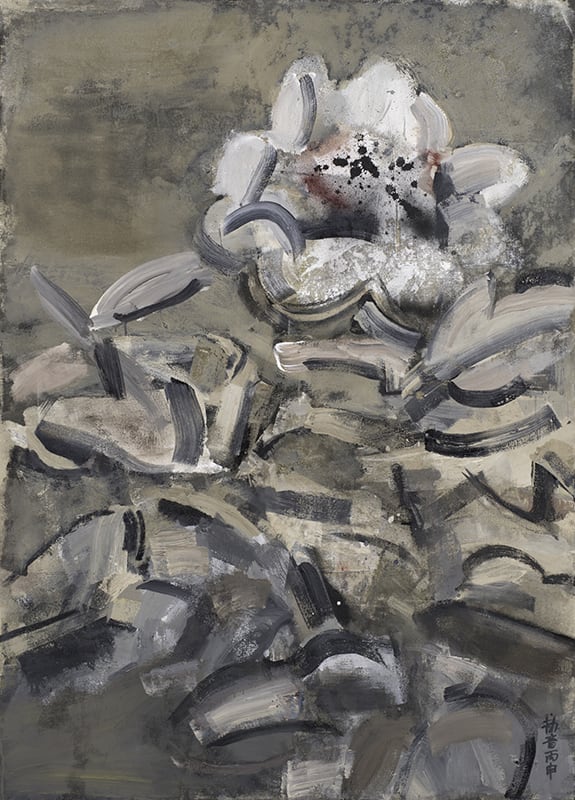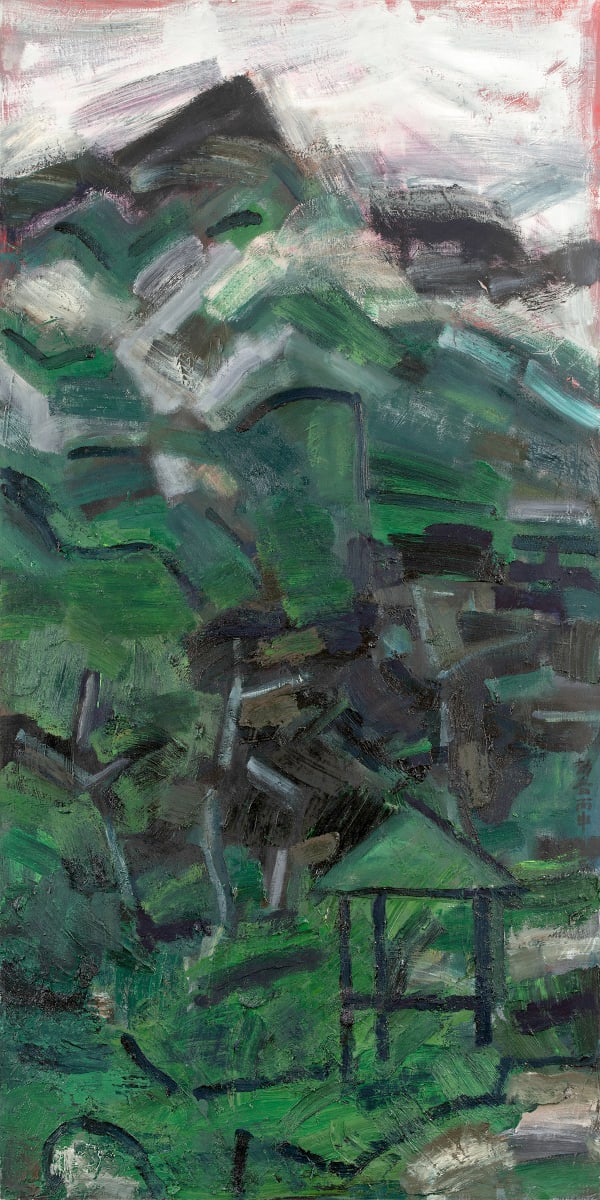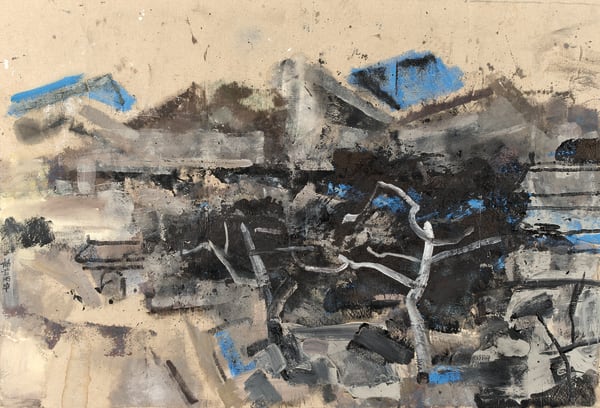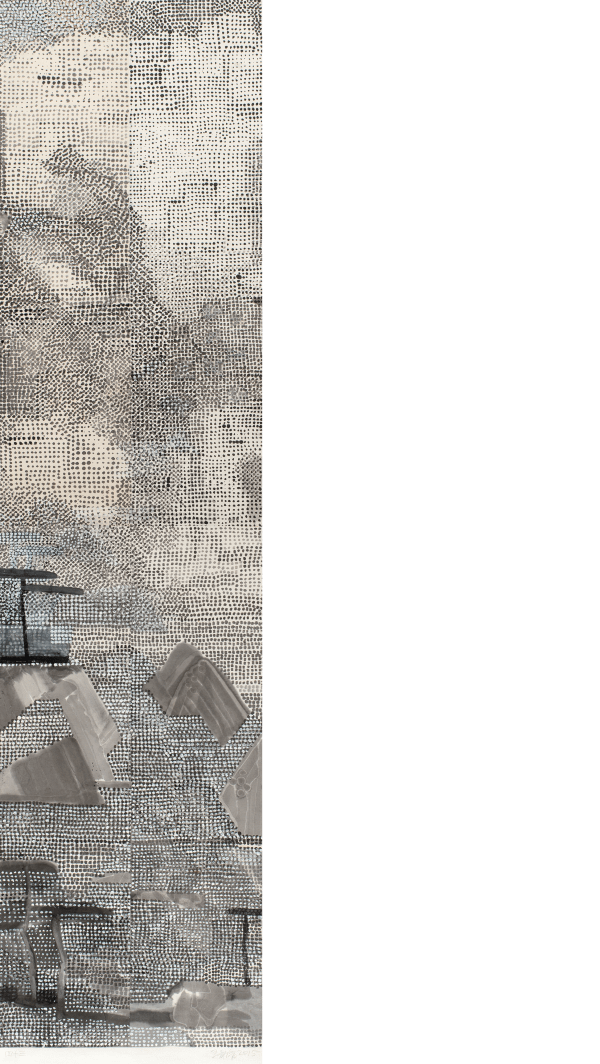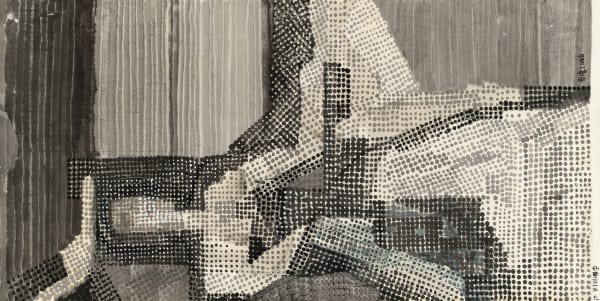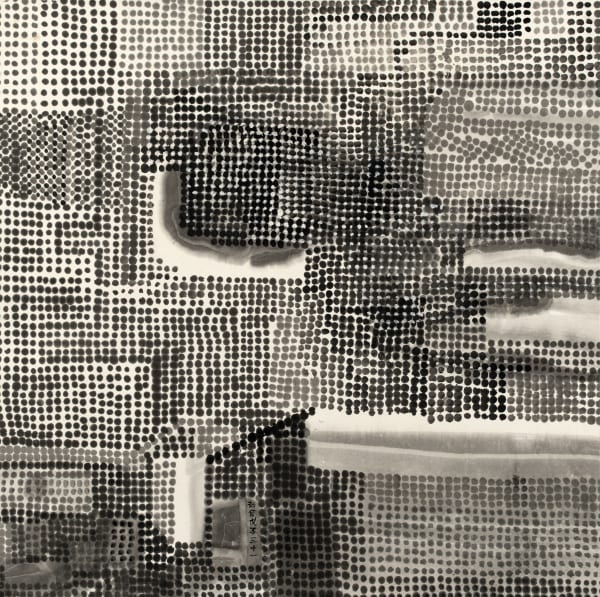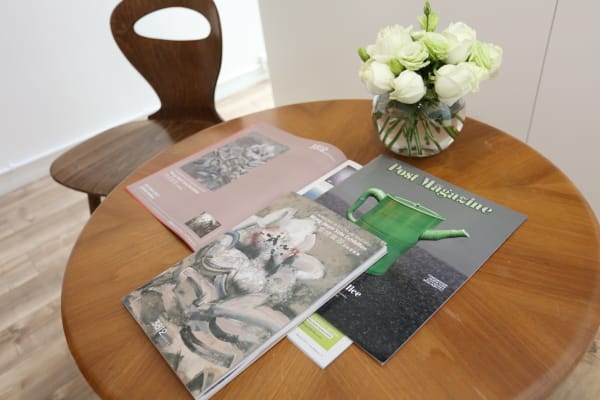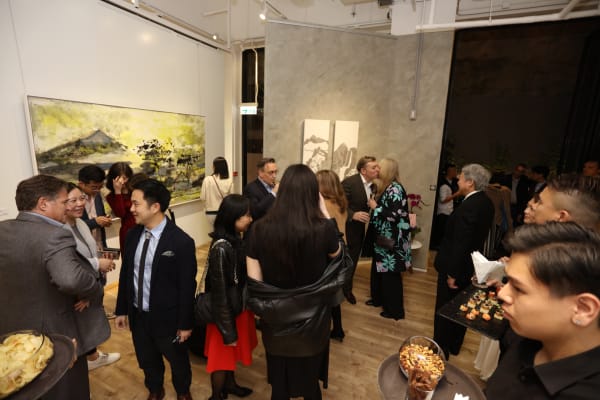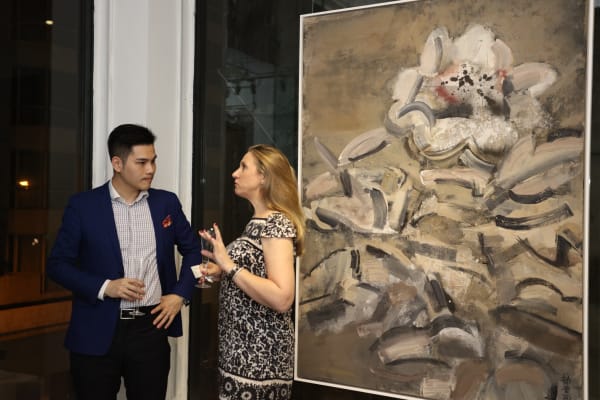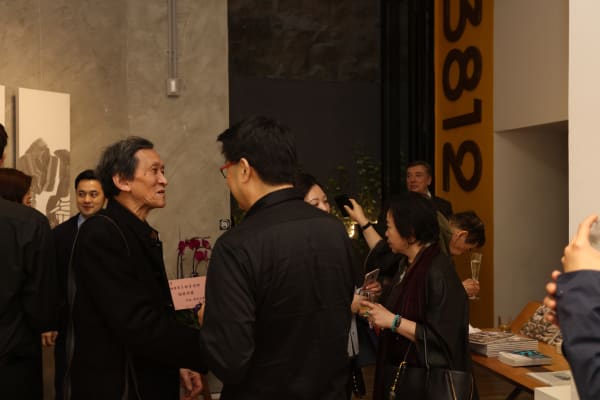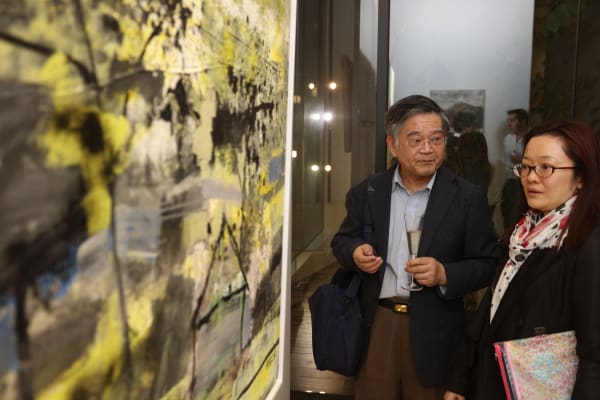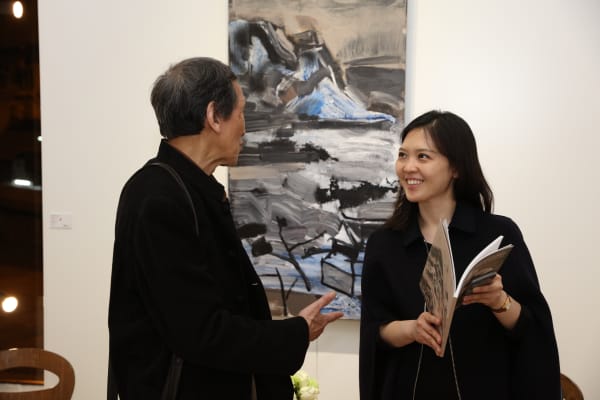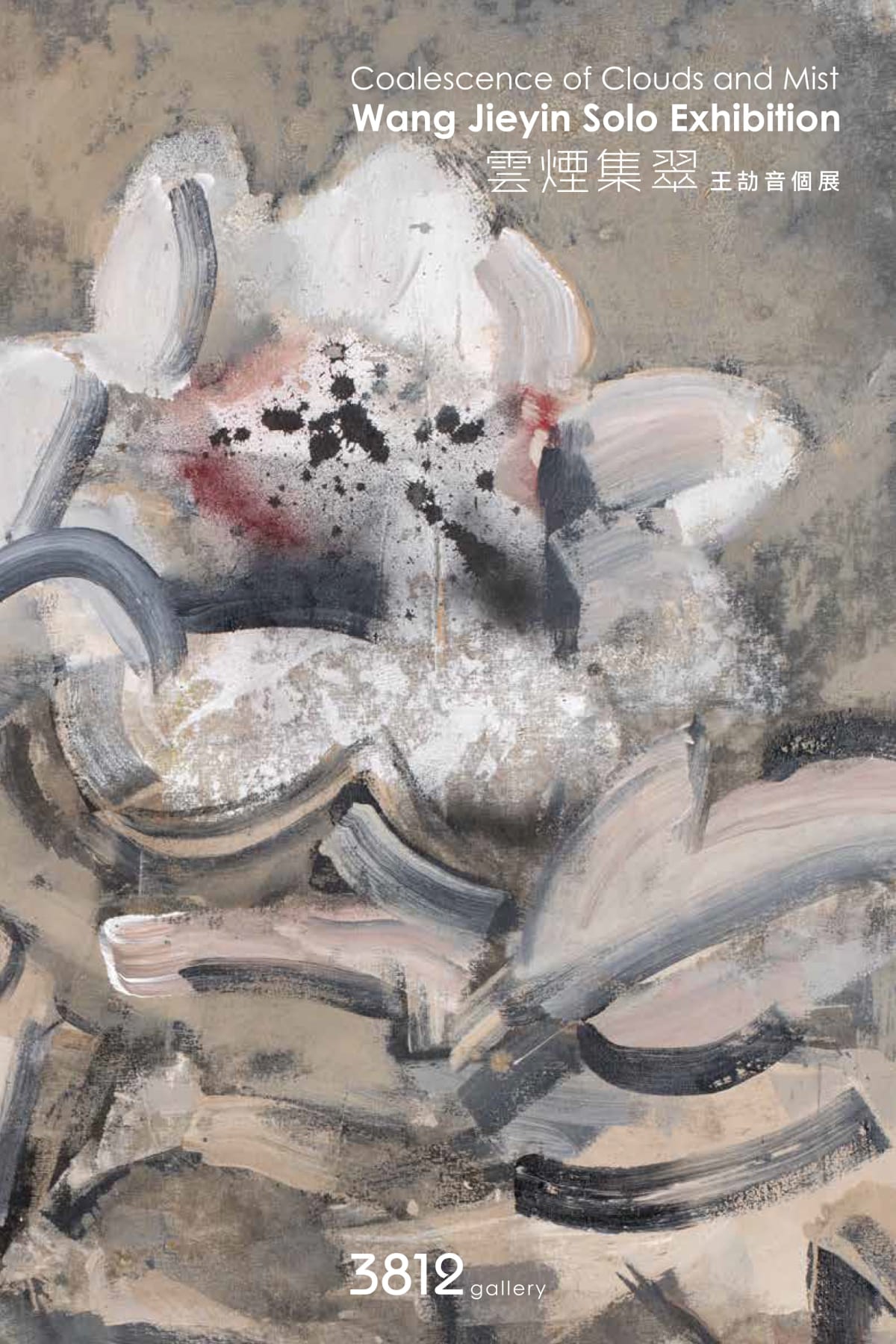Coalescence of Clouds and Mist: Wang Jieyin Solo Exhibition
By : Dr. Xia Kejun | Trans. : Jeff Crosby
Beauty emerges in that moment of looking back, that recollection of a past world, the still-glimmering echoes of things form an indelible, eternal beauty. When you see the works of Wang Jieyin, you sense the alluring return of the prosaic elegance of classical Chinese landscape and flower painting. The contribution of Chinese contemporary painting is its reawakening of the natural beauty of fleeting things, and its use of seemingly ruined forms that catalyze a concealed redemption revealing the enduring flower on the branch.
One cannot directly paint a landscape. Huang Binhong heralded the arrival of the natural dark of night and the passion of its writing. Black comes from the womb of the earth, where the coal accumulates. That deep, dark face must be caressed. The infra-image of nature can only come from the shadow traces of ancient ruins and murals, or the mountains and flowers waiting to return to slumber under the moonlight. Contemporary painting must thoroughly receive ancient and profound temporality if it is to resist the impetuousness of modernity and bring the gaze to rest. The bearing of the flower has been sliced by the knife of time. It is no longer so luscious and alluring, but outside of painting, where can its enchanting shadow be received? Wang Jieyin’s new landscapes and flower paintings appear to bear faint memories of ancient shanshui landscape painting. They actually begin with the random mottled traces of paint drips almost haphazardly laid on the canvas, shapes of mountains emerging from childlike brushwork, shapes with abstract colour fields, like the bulky volumes of rocks, which possess a beautiful rhythm in their steep inclines, in their constant undulations and fluctuations. The entire frame is filled with a misty tone, a detached fog seeping through the intersection of stone and vegetation, evoking Huang Gongwang’s overlapping cliffs, and Wang Yuanqi’s accumulations of atmosphere. Thus, the entire wooded refuge, that ancient heart that watches over our lives, blooms eternal like flowers in the night.
The new shanshui painting absorbs the spirit of the land, the serendipity of the spread of clouds and mist. The painter utilizes the way diluted acrylic paints seep into the canvas, with touches of mottled texture, to create an image that appears at first so arbitrary, like the scribbles of a child, but that on close inspection, is marvelous beyond words. The magic of art is its dissolution of the bitterness of life into formlessness. What appears on the surface to be the mutterings of a child actually radiates with the wisdom of maturity. This is the contemporary reawakening of the Chinese aesthetic of naivety. The paintings are vast and full of power, infused with the poetry of mist and night. They at once resemble charcoal drawings, remnants of ancient murals, and the shadows cast by rocks and vegetation into the world. Here, painting is not meant as an object of the gaze, but as something to breathe together with. This is the living principle of the nourishment of clouds. The flat strokes of the brush encompass colour field constructs, embedding the structures of nature in the stacked fields of colour and illusions of mist that catalyze the classic motif of peaks rising through the fog. In the murky flow of clouds, the great Empty Mountain Series reacquaints us with the feel of classic shanshui landscape painting. It possesses both the poetry of “reclining and watching the rising clouds” and the Zen philosophy of the “empty mountain with no person seen.” At once so naïve and so penetrating, this is the contemporary reconstruction of China’s unique aesthetic of “starkness.”
Chinese contemporary painting differs from Western painting in its full reception of the vast traces of time and history, and of the primal memories of nature. Between sparse, loose brushwork and an imagery of ancient elegance, the painting embodies the purity and serenity in the artist’s heart. Wang Jieyin’s artwork embodies the “principles of the nature of ink.” In this exhibition, there is an internal dialogue between acrylic and ink that returns things to their simplest state, restores them to their point of origin, like traditional shanshui paintings that project a massive landscape through tiny “moss points.” What appears at first to be abstract encompasses the undulating profile of nature, showing us this old artist’s great courage in delving into the profound depths of existence.
When we gaze at those flowers, their tones are another kind of Chinese colour, an aesthetic of infra-mince colour. It begins with simple colours, appearing black and white at first, but it includes greens and browns, the “shadows reflecting back into the forest to shine on the moss.” In Wang Jieyin’s hands, the painted surface generates a fresh yet shadowy placenta marked by the naïve compositions and ancient colour tones of the murals of Dunhuang, and the swaying of flowers in the height of bloom. The silhouette-like composition calls to mind the simplicity of Matisse’s late period paper cut-outs, but also evoke the turbulent folds of clothing in figure painting. Wang Jieyin’s works embody the allure of Chinese contemporary painting in their ability to integrate fields of Western abstraction with the freehand line of Chinese tradition in a naively romantic and vividly poetic fashion, thus reviving the phantom beauty of nature by mending the rifts in time between fashion and timelessness, profundity and fascination, ancientness and sensuality.
The myriad things of this world grow and blossom like flowers. Painting merely brings this splendor slightly closer. In these wondrous works of art, it is as if the entire world has just awakened, revealing its hazy poeticism in a moment of distraction. The painter brings these things of nature to reveal their magical forms in the painting, sometimes as a coalescence of mist and smoke, sometimes as the tones blossoming and wilting, a posture of openness of painting itself. Between classical Chinese art and Western abstraction, Wang Jieyin’s works are like the emerald voices rising from the empty mountain, emanating the fragrance of dark orchids. Today’s Chinese painting restores the depth and poetry of classical imagery, but also uses the spontaneity of the present. It is actualized through a paradoxical manner that seems at once accessible and impossible. This artist in his seventh decade has shown us once again the beauty and dignity of painting and the mystery of the nourishment of clouds.
-
 Wang Jieyin 王劼音, Flowers《花卉》, 2015
Wang Jieyin 王劼音, Flowers《花卉》, 2015 -
 Wang Jieyin 王劼音, Orchids《蘭花》, 2016
Wang Jieyin 王劼音, Orchids《蘭花》, 2016 -
 Wang Jieyin 王劼音, Light of Dawn《晨光》, 2015
Wang Jieyin 王劼音, Light of Dawn《晨光》, 2015 -
 Wang Jieyin 王劼音, Green Pavilion《綠亭》, 2016
Wang Jieyin 王劼音, Green Pavilion《綠亭》, 2016 -
 Wang Jieyin 王劼音, Grand Landscape《大山水》, 2016
Wang Jieyin 王劼音, Grand Landscape《大山水》, 2016 -
 Wang Jieyin 王劼音, Sound of River《江聲》, 2016
Wang Jieyin 王劼音, Sound of River《江聲》, 2016 -
 Wang Jieyin 王劼音, Dwelling 1《幽居(一)》, 2017
Wang Jieyin 王劼音, Dwelling 1《幽居(一)》, 2017 -
 Wang Jieyin 王劼音, Classical Landscape I《古典山水 I》, 2006
Wang Jieyin 王劼音, Classical Landscape I《古典山水 I》, 2006 -
 Wang Jieyin 王劼音, Landscape Notes No.21《山水筆記 21》, 2010
Wang Jieyin 王劼音, Landscape Notes No.21《山水筆記 21》, 2010 -
 Wang Jieyin 王劼音, Landscape Notes No.43《山水筆記 43》, 2015
Wang Jieyin 王劼音, Landscape Notes No.43《山水筆記 43》, 2015 -
 Wang Jieyin 王劼音, Landscape Notes No.44《山水筆記 44》, 2015
Wang Jieyin 王劼音, Landscape Notes No.44《山水筆記 44》, 2015 -
 Wang Jieyin 王劼音, Ethereal No.9《飄渺No.9》, 2013
Wang Jieyin 王劼音, Ethereal No.9《飄渺No.9》, 2013 -
 Wang Jieyin 王劼音, Ethereal No.12《飄渺 No.12》, 2014
Wang Jieyin 王劼音, Ethereal No.12《飄渺 No.12》, 2014 -
 Wang Jieyin 王劼音, Ethereal No.15《飄渺 No.15》, 2014
Wang Jieyin 王劼音, Ethereal No.15《飄渺 No.15》, 2014 -
 Wang Jieyin 王劼音, Ethereal No.24《飄渺No.24》, 2014
Wang Jieyin 王劼音, Ethereal No.24《飄渺No.24》, 2014 -
 Wang Jieyin 王劼音, Circle Dot Imagery No.2《圓點圖像 No.2》, 2007
Wang Jieyin 王劼音, Circle Dot Imagery No.2《圓點圖像 No.2》, 2007 -
 Wang Jieyin 王劼音, Circle Dot Imagery No.3《圓點圖像 No.3》, 2009
Wang Jieyin 王劼音, Circle Dot Imagery No.3《圓點圖像 No.3》, 2009

